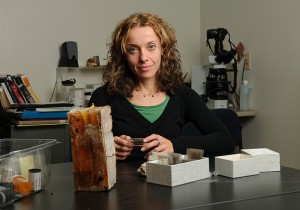
Archaeology student Tiziana Matarazzo conducts her field research in what used to be her own back yard. Matarazzo grew up close to Mount Vesuvius in southern Italy.
A Ph.D. candidate in the Department of Anthropology with a research interest in micromorphology – a branch of soil science that involves microscopic analysis – she studies the composition of soil in the early Bronze Age village of Afragola in the province of Naples.
Matarazzo says the village is particularly important “because it dates from a time when society in Italy was just beginning to transition to social complexity.”
Assisted, in part, by an archaeology doctoral dissertation research improvement grant from the National Science Foundation, Matarazzo’s research involves the analysis of micromorphological thin sections of archaeological deposits in sites throughout the village. Her findings will assist in reconstructing the economic and social organization of Bronze Age communities, and will help define a wide range of domestic, ritual, and manufacturing activities.
Her major advisor, Natalie Munro, an associate professor of anthropology in the College of Liberal Arts and Sciences, says Matarazzo is a valuable asset to her lab. “Tiziana offers a fresh research perspective. She is the only micromorphologist in a lab dominated by zooarchaeologists [those who study animal bones], yet she addresses similar research questions as other students in the lab. Her unique insight into other students’ research forces them to learn by looking at their questions from a new direction.”
Afragola, located on the Campania Plain near Naples, was discovered in the summer of 2005 during the construction of a high-speed train line. The site was excavated between summer 2005 and winter 2007 by a multidisciplinary team under the direction of the Soprintendenza Archeologica of Napoli and Caserta. It is a medium-sized village comprised of about 27 architectural features, including large structures arranged in a horseshoe shape, fences, silos, and other yet to be explored areas.
The site is exceptionally well preserved because it was covered by one meter of ash during an eruption of Vesuvius in the year 3780BP, approximately 2,000 years before the eruption that covered Pompeii in 79 AD. Unlike Pompeii, however, no human bones have been found, because inhabitants had time to flee the initial lava flow.
Perfectly preserved footprints indicate that once the lava cooled during a pause in the eruption, residents had time to briefly return to the village. But they did not have time to salvage their belongings before finally abandoning their dwellings.
During the early phase of the eruption, a wave of mud slowly penetrated the village structures, creating a cast of the inside of the huts that reveals a negative impression of their contents, including wicker and wood baskets, poles, and grains. The mud also sealed the entire surface, producing a largely anaerobic environment that protected the site against both natural and human disturbances.
Matarazzo, who holds a BA in geophysics from the University of Italy, was originally planning on becoming a geologist. However, after she came to UConn and took a course in human evolution, she decided to pursue a research project that combines her interests in micromorphology, early civilization, and her native country, Italy.
Munro describes Afragola as an unusually good research site because the village, in effect, “provides a natural laboratory to record the signatures of different types of activities.” She says Matarazzo’s research has the potential to make an important methodological contribution.
With her dissertation defense on the horizon in 2010, Matarazzo hopes to continue her research as a post doctoral fellow. She took 220 samples from Afragola and has analyzed only 90 of them for her dissertation. With her love of research and her desire to ‘give something back’ to her native country, it’s likely that ancient pieces of Afragola will remain under her microscope for quite some time.


